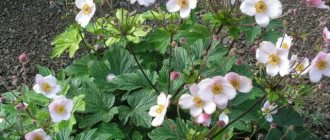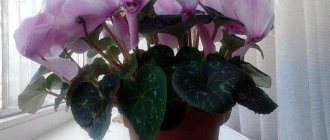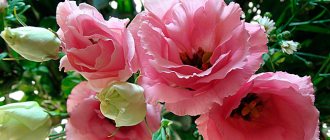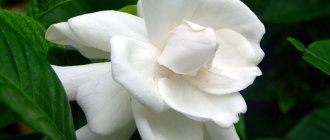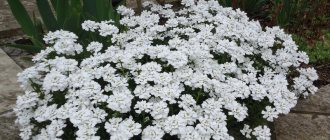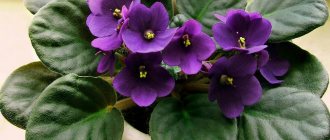Anemones or anemones are a very extensive genus of plants, containing about 160 species that have fundamental differences from each other. Among them there are spring- and autumn-flowering species, with tubers and rhizomes. The colors and structure of flowers can also be quite varied. Oak anemone is a flower that symbolizes the arrival of spring and is distinguished by its unpretentiousness in cultivation and charming appearance.
Description of the Dubravnaya anemone
Anemone or wood anemone (Anemonenemorosa) is a perennial plant of the Ranunculaceae family. It has a creeping and very branched rhizome, thanks to which it retains the ability to grow quickly and form entire carpets of white flowers.
Translated from Latin, the name of the flower means “daughter of the winds,” as evidenced by its Russian name. As soon as the wind blows slightly, the flowers begin to perform an amazing and intricate dance. And this happens due to the fact that the flowers lack sepals. Therefore, the petals are so vulnerable to any air vibrations.
The second name of the flower tells about its favorite habitat in nature. Indeed, most often the anemone lives in deciduous and mixed forests, on the edges or in the shrubby undergrowth and blooms immediately after the snow melts. Therefore, people often call this flower a snowdrop.
Comment! If suddenly an anemone flower was found in a spruce forest, then, most likely, oak trees once grew in this place, but were subsequently forced out of their place by spruce trees.
Oak anemone is an ephemeroid. This means that after flowering and seed ripening, the entire above-ground part of the plant dies. Only the rhizomes remain in the ground. This happens around June or July, depending on the climatic conditions of the region. Seeds spread in large quantities around plants; ants especially like to spread them, and over considerable distances. Even though the germination rate of anemone seeds is not too high, in the spring many new young plants sprout around the bushes and at a distance. In the first year they only have a small stem with a leaf. And only in the second year can one observe the appearance of a full-fledged leaf from under the ground.
Oak anemone is a herbaceous plant for open ground; it reaches a height of no more than 15-20 cm. The leaves, cut three times in a rich green hue, distinguish the anemone from other spring plants. The plants form bright green curtains, from which long peduncles with snow-white flowers fluttering in the wind emerge one by one. Their diameter can vary from 4 to 6 cm. On the outside, the petals of the oak forest anemone have a barely noticeable purple tint, which is clearly visible in the photo.
The flowers of the oak anemone react to cloudy and rainy weather - they close and droop. At the same time, when the sun comes out, they fully open their petals towards it. Flowering period is average - about a month. Approximately from mid-April to mid-May. Each individual flower can live from 6 to 15 days.
Like other representatives of the buttercup family, oak anemone is a poisonous plant. It contains a substance (protoanemonin) that is irritating to human mucous membranes and skin. A particularly high concentration of this substance is found in the rhizomes. Therefore, people prone to allergic reactions need to be careful when dealing with this plant, especially when planting or replanting.
Oak anemone is a long-liver, especially in comparison with other herbaceous plants. One bush can live up to 50-60 years. But it blooms in natural conditions only at 10-12 years of age. However, varietal cultivated forms of anemone begin to bloom much earlier - already 2-3 years after sowing.
Choosing a place to grow
For cultivation of an artificial form, anemone is attractive for its external characteristics, as well as the period and duration of flowering. The flower gives its beauty when the rest of the ornamental plants in the garden are just waking up after wintering.
In addition, the anemone is perennial, which allows it to delight the gardener’s eye for ten years, or even longer. A very pleasant addition is also the fact that anemone is resistant to diseases and pests. The latter is due to the fact that the flower is poisonous and is not to the taste of harmful bugs and various insects.
The oak anemone flower prefers light, but slightly shaded areas of the garden. You should not expose it to scorching direct sunlight. The best option would be a place under the wide crowns of trees.
It is advisable to provide the soil with a sandy type, moist and humus. In this case, the soil should be kept moist throughout the season, even after the upper part of the plant dies. Also, the soil should be loose and fertile.
Varieties of oak anemone
Breeders did not ignore this charming flower, and based on it, many cultivated varieties of various colors were bred.
The following varieties of oak anemone are known:
- Allenii - a variety with an abundance of lavender flowers;
- AlbaPlena – small white and double flowers;
- Robinsoniana is an old variety with large, simple, soft lilac flowers;
- Rosea is a profusely flowering variety with simple, small, soft pink flowers;
- Kentish Pink - this variety of anemone is distinguished by simple large pink flowers with a purple tint;
- Bluebeauty - anemone with bronze foliage and large, simple blue flowers;
- Blue Eyes is an interesting variety with double large white flowers with a blue “eye” in the middle;
- Royalblue - anemone with simple flowers of a bright blue-blue hue;
- Vestal is a variety of oak anemone with large white double flowers;
- Virescens is an exotic variety of oak anemone with green flowers.
How poisonous is the flower?
Oak anemone, the description of which in many reference books includes a mention of its toxicity, is not poisonous in the generally accepted sense. That is, if you decorate your summer cottage with a flowerbed with these bright white saucer flowers or bring a bouquet of them into the house, your health will not worsen.
Article on the topic: Poisonous lettuce - beneficial properties, description
The danger arises from prolonged contact with plant sap without the use of gloves or other protective equipment. This means that if you pick a couple of flowers to put in a vase, nothing bad will happen. But when preparing plant materials, you need to wear gloves. Prolonged skin contact with anemone juice leads to local dermatitis, similar in appearance to chemical burns.
Planting anemone
Since the main growing season of oak anemone occurs in spring, the most favorable time for planting it is autumn. Moreover, this applies to planting with seeds and segments of rhizomes.
Seed preparation
Seeds quickly lose their viability. Therefore, it makes sense to sow only seeds freshly harvested this season (summer) in the fall before winter. At home, you can postpone the sowing of seeds to spring, but in this case they need stratification in the cold for several months.
But the germination rate of the seeds is low (up to 25%), so it is still better to use the vegetative method of propagating oak anemone.
Site selection and soil preparation
To plant oak anemone, choose a place that is most similar to its natural growing conditions. In spring, this place should have a sufficient amount of sunlight, and in summer, partial shade should prevail. It is ideal to plant these flowers under the canopy of a young orchard or along the edges of small shrubs.
The ideal soil for planting anemone is loose, fairly fertile, without stagnant water, but with moderate moisture. Wild wood anemone plants can even tolerate increased soil acidity, since they often grow in swampy areas. But cultivated varieties can be more demanding in this sense; they will need, at a minimum, a neutral soil reaction.
Since the rhizome in the ground continues its growth and development after the above-ground part dies, care must be taken to ensure that the soil in this place remains fairly moist throughout the summer.
How many types of flower are there?
Oak anemone, a photo and description of which is in every reference book on medicinal plants of the European part of Russia and in botanical encyclopedias, is a type of flower found in deciduous forests.
Experts have currently counted 150 different varieties of anemone, making up three large conditional species groups, named according to their preferred habitat:
All plants are similar to each other, they are distinguished only by minor external details.
Species related to buttercups are not so difficult to find in any Russian field or meadow. They also grow in large, well-lit and ventilated forest clearings.
Oak forest varieties prefer deciduous forests with little shade. Oak groves are especially fond of the flower. For example, in France, where oak forests have remained the same as centuries ago, every spring the space between the centuries-old trees flashes with the snow-white lights of blossoming anemones. Its flowering was “recorded” by many European painters. There is an image of anemone blooming in the Bois de Boulogne on medieval tapestries.
In Russia, these plant varieties prefer deciduous or mixed forests. They can often be found in birch or aspen groves, among maple thickets or in the vicinity of mountain ash, linden and other trees. Anemone also grows in the city. The plant is extremely unpretentious.
However, when the deciduous forest is replaced by coniferous trees, especially spruces, the oak anemone “retreats”, and its place is taken by forest varieties of the flower. There are almost no external differences between them; forest varieties are distinguished by shorter growth, small flowers in comparison with others, and a thicker stem with fewer leaves.
Anemone propagation methods
The easiest way to propagate oak anemone is using vegetative methods.
Rhizome segments
The most common method of propagation is by cuttings of rhizomes. It is necessary to cut the rhizomes into pieces, each of which will have at least one, or preferably several buds.
It is advisable to plant in July or August after the green aerial part of the anemone has already completely died off. Plant segments of rhizomes to a depth of 8-10 cm.
Dividing the bush
The propagation method by dividing the bush is even simpler, since it is better to dig up the plants and divide them into parts somewhere in late June or July, when there are still some leaves left on them.
It is not recommended to excessively deepen the separated parts of the anemone bush into the ground. It is advisable to plant them at a depth of 5 to 10 cm. The root collar should be located exactly at ground level. Usually, anemone takes root easily, and next year in the spring it will delight with fresh leaves, and perhaps even flower stalks.
The healing power of primrose
Among the characteristics of wild-growing anemone, one of the most valuable is the medicinal purpose of the plant. Used only in folk medicine. It has anti-inflammatory, analgesic, antispasmodic and diaphoretic properties. Anemone herb is used for diseases of the heart, stomach, and also in the treatment of whooping cough, gout, paralysis, pneumonia, and dermatoses.
Most often, anemone herb is collected for external use in the form of compresses to relieve rheumatism and gout. Various lotions or washes are popular in the case of non-healing wounds or dermatoses.
To make the infusion, dry anemone grass is crushed, two teaspoons are poured into a glass container and a glass of not hot, but boiled water is poured. They insist for a day.
The use of any dosage forms from anemone nemorosa is strictly prohibited:
- pregnant women, because its abortive properties are noted;
- suffering from kidney inflammation.
Even when collecting anemone herb for external use, precautions must be taken by using gloves. Reckless behavior may result in burns to the skin and mucous membranes.
Features of care
What is especially good about the oak anemone is that it does not require special attention. If the right place is chosen for it, then after final rooting it will remind itself only by the appearance of charming snow-white flowers at a time when most plants are just beginning to wake up from winter hibernation.
Additional watering for anemone is necessary only in the event of an abnormally warm or dry spring. Or if there is a drought in the summer and the soil in the place where it is planted begins to dry out and crack.
It is good to immediately mulch the area with a layer of leaves from fruit or other suitable deciduous trees immediately after planting bushes or rhizomes. Moreover, it is better to leave a certain layer of leaves to protect the planting site from freezing in winter, and from drying out in summer.
Of course, like many plants, oak anemone will be grateful for fertilizing. But it is better to use organic fertilizers in liquid form. Enough to feed:
- leaves beginning to appear in early spring;
- bushes already retiring in May with diluted green fertilizer.
But weeding anemone bushes is not recommended, since the roots of these plants live in close proximity to the surface of the earth. It is allowed only immediately after rain or watering to carefully remove the largest or frankly interfering weeds.
Preparing for winter
In general, oak anemone is a very frost-resistant plant. But flower buds on the rhizomes are formed in the summer and by autumn they are already fully formed. If the winter turns out to be particularly frosty, then they have a chance to die. In this case, it is unlikely that you will be able to observe anemone blooming in the spring, or it will be very sparse.
In order to protect the established flower buds from frost, the entire root zone is covered with a layer of peat mixed with humus, a layer of at least 5 cm. A layer of fallen leaves is also placed on top. And after snow falls, they try to preserve as much snowdrift as possible in this place.
Pest and disease control
Oak anemone is particularly resistant to pests and diseases, as it contains toxic substances that repel potential enemies.
The only thing that can threaten the anemone is slugs, which can eat its young leaves. There are many ways to combat them: traps, baits, special granules that must be used in combination.
Diseases and pests
Oak anemone is highly resistant to diseases and harmful insects, but sometimes problems can occur with growing the plant in summer cottages. For example, due to increased humidity in the soil, anemone can be affected by slugs. To prevent the death of the flower, it is recommended to carry out pest control in a timely manner. In this case, containers filled with chlorinated water are placed next to the plants - they will repel slugs.
Sometimes perennial bushes are affected by a nematode. This usually happens when planting in areas with contaminated soil. This disease is manifested by a change in the shape of the stems and leaves, after which the flower begins to fade. If such a disease occurs, it is recommended to immediately remove diseased plants from the site and not plant anemone on it for several years.
Read more about varieties and care features below.
Oak anemone in landscape design
The oak anemone can serve as a decoration for the garden precisely at a time when the eye is not yet tired of the riot of floral colors and nature is just beginning to wake up.
Its delicate flowers look very touching among young grass under the canopy of an orchard or not too dense ornamental shrubs.
Specially bred cultivated varieties are generally so beautiful that they themselves attract attention. For example, an oak anemone of the Vestal variety can serve as an independent accent in a spring flower bed. It will be impossible to pass by it without improving your mood from admiring the snow-white fluffy beauties.
The anemone will also look good on the lawn in a semi-shaded place. Just understand that in this case, mowing the lawn will have to be postponed until the leaves die off on their own. Otherwise, the rhizomes may be damaged.
Other spring-flowering perennials are ideal as neighbors for the oak anemone: liverworts, corydalis, lungworts, primroses, white flowers, chionodoxes.
How to choose the right tubers
The key to successful cultivation of tuberous anemone is the purchase of high-quality planting material, which can be purchased in specialized flower shops towards the end of winter. Most often, tubers are sold in branded packaging, which contains recommendations for storage and planting dates. As a rule, they have already been treated with fungicides to prevent various diseases.
As can be seen from the photo, anemone tubers, as a rule, are irregular in shape and have a small size (1 - 3 cm). They look like flattened dried lumps with an uneven surface with tubercles, grooves and growths. Depending on the variety, their color can be brown or dark earthy.
In healthy specimens, the color is uniform, there are no black spots or traces of mold on the surface. They are solid to the touch and there should be no voids inside. When purchasing planting material in a retail chain, it is important to know that it has a fairly low germination rate: out of 5 tubers, usually only one is viable.
Healing properties of oak anemone
Despite the fact that oak anemone contains toxic substances, it is also a rather valuable medicinal plant. The herb and preparations containing it are used mainly in folk medicine and homeopathy.
Characterized by the following properties:
- painkillers;
- antifungal;
- sedative and antispasmodic;
- expectorants;
- anti-inflammatory;
- bactericidal;
- sweatshops.
Anemone herb is most often collected and used for external use in the form of lotions, washes and compresses for gout, rheumatism, various dermatoses and non-healing wounds.
Its beneficial effects are known in the treatment of whooping cough, pneumonia, migraines, diseases of the heart, stomach, and genital organs.
Important! It is strictly not recommended to carry out treatment with drugs prepared independently without consultation with specialists.
It is prohibited to use wood anemone for treatment:
- pregnant and lactating women;
- suffering from kidney inflammation.
Even when collecting herbs, it is better to use gloves, since if your skin is hypersensitive, it can be damaged.
Why is the plant called that?
Why the oak anemone was called this is of interest to many people, even those not involved in botany. The word anemone was used by the Slavic tribes inhabiting the European part of modern Russia to call everything that swayed from the blows of air. For example, small bright strips of fabric were also called, acting as a kind of weather vanes and scaring away evil spirits from settlements and houses. Ribbons that decorated girls' hairstyles and swayed when they moved were also called anemones.
The flower begins to tremble even with the lightest breeze. Moreover, this sensitivity of the plant to air movement was noticed not only by the Slavs. The Greek word anemos, which formed the basis of the Latin name anemone nemorosa, is translated into our language as wind. And in Germany, this amazingly beautiful forest honey plant is called windflower, which literally means windy flower.
